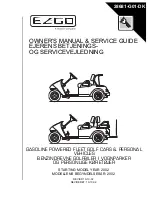
21
MAINTENANCE
Read all of this manual to become thoroughly familiar with this vehicle. Pay particular attention to all Notices, Cautions, Warnings, and Dangers.
MAINTENANCE
VEHICLE CLEANING AND CARE
To reduce the possibility of severe injury or vehicle damage, read and understand all instructions
supplied by manufacturer of pressure washer.
When pressure washing exterior of vehicle, do not use pressure in excess of 700 psi and maintain a 12”
minimum distance from spray nozzle to painted surface. To reduce the possibility of cosmetic damage, do
not use any abrasive or reactive solvents to clean plastic parts.
It is important that proper techniques and cleaning materials be used. Using excessive water pressure may cause
severe injury to operator or bystander, damage to seals, plastics, seat material, body finish or electrical system. Do not
use pressure in excess of 700 psi to wash exterior of vehicle.
Clean windshield with lots of water and a clean cloth. Minor scratches may be removed using a commercial plastic pol-
ish or Plexus
®
plastic cleaner available from the service parts department.
Normal cleaning of vinyl seats and plastic or rubber trim requires the use of a mild soap solution applied with a sponge
or soft brush and wipe with a damp cloth.
Removal of oil, tar, asphalt, shoe polish, etc. will require the use of a commercially available vinyl/rubber cleaner.
The painted surfaces of the vehicle provide attractive appearance and durable protection. Frequent washing with luke-
warm or cold water and mild detergent is required to preserve the painted surfaces.
Occasional cleaning and waxing with non-abrasive products designed for ‘clear coat’ automotive finishes will enhance
the appearance and durability of the painted surfaces.
Corrosive materials used as fertilizers or for dust control can collect on the underbody of the vehicle. These materials
will cause corrosion of underbody parts unless flushed occasionally with plain water. Thoroughly clean any areas where
mud or other debris can collect. Sediment packed in closed areas should be loosened to ease it’s removal, taking care
not to chip or otherwise damage paint.
COMMON SENSE OPERATION
This vehicle is not a toy.
If not operated properly and responsibly, it can cause severe injury or death to the operator,
passengers or bystanders. All operators should possess a valid driver’s license. Children should not be permitted to
operate the vehicle. Children may not have the skill, judgement or strength to operate this or similar vehicles.
Do not operate vehicle under influence of alcohol or drugs. Many prescription and over the counter medications reduce
the ability of the driver to operate the vehicle safely. Always review side effects of any medication with a doctor or phar-
macist before operating vehicle.
When driving on an unpaved road, loose surfaces or wet grass, vehicle stopping distance will increase. If the vehicle is
fully loaded, it will take longer to stop than with no load. When operating vehicle in wet weather conditions, remember
that the brakes may need to be
lightly
applied in order to provide enough friction to dry the brake unit. If wet, the
brakes will lose much of their effect.
Slow down when in unfamiliar terrain. Slow down when cresting a hill in an unfamiliar area.
Some hills are too steep to climb. If attempting to climb a hill that is too steep or if unable to achieve adequate traction,
do not attempt to turn around on the hill. Slowly back straight down the hill using the service brake to control
speed.

































